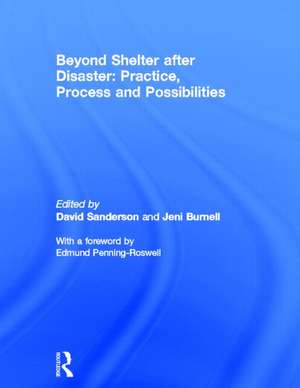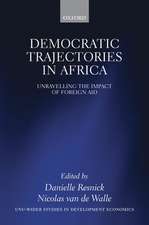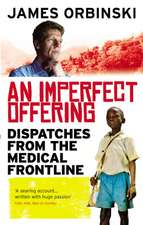Beyond Shelter after Disaster: Practice, Process and Possibilities
Editat de David S. Anderson, Jeni Burnellen Limba Engleză Hardback – 18 mar 2013
This book explores the issues in three parts. The first, Practice, looks at lessons from past efforts. Part two, Process, proposes practical and effective people-centred approaches. Part three considers currently neglected issues such as disability, human rights and urban-oriented approaches. Through practical case studies and academic research, Beyond Shelter after Disaster critiques past methods and explores future options for improving practice in one of the most complex areas of post disaster relief and recovery.
This book was originally published as a special issue in Environmental Hazards: Human and Policy Dimensions.
| Toate formatele și edițiile | Preț | Express |
|---|---|---|
| Paperback (1) | 309.90 lei 22-36 zile | +17.17 lei 5-11 zile |
| Taylor & Francis – 14 oct 2024 | 309.90 lei 22-36 zile | +17.17 lei 5-11 zile |
| Hardback (1) | 765.04 lei 43-57 zile | |
| Taylor & Francis – 18 mar 2013 | 765.04 lei 43-57 zile |
Preț: 765.04 lei
Preț vechi: 1027.91 lei
-26% Nou
Puncte Express: 1148
Preț estimativ în valută:
146.39€ • 153.25$ • 121.13£
146.39€ • 153.25$ • 121.13£
Carte tipărită la comandă
Livrare economică 07-21 aprilie
Preluare comenzi: 021 569.72.76
Specificații
ISBN-13: 9780415814232
ISBN-10: 0415814235
Pagini: 176
Dimensiuni: 189 x 246 x 15 mm
Greutate: 0.5 kg
Ediția:New.
Editura: Taylor & Francis
Colecția Routledge
Locul publicării:Oxford, United Kingdom
ISBN-10: 0415814235
Pagini: 176
Dimensiuni: 189 x 246 x 15 mm
Greutate: 0.5 kg
Ediția:New.
Editura: Taylor & Francis
Colecția Routledge
Locul publicării:Oxford, United Kingdom
Public țintă
AcademicCuprins
1. Introduction. Beyond shelter after disaster: practice, process and possibilities Part one: practice 2. What have we learned from 40 years’ experience of Disaster Shelter? 3. Harnessing time: Reflections on constraints to development 4. Post-disaster reconstruction: A current analysis of Gujarat’s response after the 2001 earthquake Part two: process 5. Resilient dwellings or resilient people? Towards people-centred reconstruction 6. Community-led resettlement: from a flood- affected slum to a new society in Pune, India 7. Lost in translation? The challenges of an equitable post-disaster reconstruction process: lessons from Chile Part three: possibilities 8. Is there a human right to shelter after disaster? 9. Can humanitarian responses in urban areas reinforce underlying causes of vulnerability? Tweaking a livelihoods analysis of inequality and infrastructure in splintering cities 10. From research to practice (and vice versa) for post-disaster settlement and shelter 11. Disability and public shelter in emergencies
Descriere
Beyond Shelter after Disaster critiques past approaches and explores future options for improving practice in one of the most complex areas of post disaster relief and recovery.
This book was originally published as a special issue in Environmental Hazards: Human and Policy Dimensions.
This book was originally published as a special issue in Environmental Hazards: Human and Policy Dimensions.
Notă biografică
David Sanderson has over 20 years’ experience in humanitarian aid, mostly with NGOs. He is currently a Professor and Director of the Centre for Development and Emergency Practice (CENDEP) at Oxford Brookes University.
Jeni Burnell trained as an architect before pursuing a career in community art, architecture and development. She has a Master’s degree in development and emergency practice and is currently a Research Associate at CENDEP, Oxford Brookes University. Her specialisations include shelter after disaster and community-led development using the ‘Small Change’ approach.
Jeni Burnell trained as an architect before pursuing a career in community art, architecture and development. She has a Master’s degree in development and emergency practice and is currently a Research Associate at CENDEP, Oxford Brookes University. Her specialisations include shelter after disaster and community-led development using the ‘Small Change’ approach.















